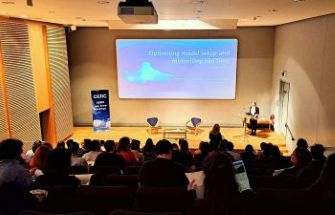CERC news
< Previous12345678910111213141516171819Next >


21 Nov 2025Heathrow Airport expansion proposal: air quality sensitivity analysis
As part of the review of the Airports National Policy Statement (ANPS), the UK Government assessed Heathrow Airport expansion proposals produced by seven organisations. Two schemes remain under active consideration by the Government. For one of these, the Heathrow West scheme, promoted by Arora Group / Heathrow West Limited, CERC was part of a support team of specialist consultants engaged by Arora Group for their submission to the ANPS review. For the proposed expansion scheme, which includes a 2,800 m third runway, CERC's air quality analysis included:
- a semi-quantitative analysis of operational phase human health impacts;
- a qualitative analysis of relative potential effects at ecological receptors; and
- a further qualitative analysis of construction phase impacts.
As part of our analysis, we considered potential traffic disruptions during the construction of road schemes relating to airport expansion. These were based on disruption caused by current works for upgrading M25 Junction 10; the figure shows traffic speeds recorded for a section of the M25 before and during the works. This is an area of concern for which the Government has requested further information from promoters of the two remaining schemes. CERC's report is included as Appendix D of Arora Group's submission, with a summary of the air quality analysis in Section 10.

22 Oct 2025Amines chemistry module online training course offered by CERC
CERC are pleased to announce that we offer an updated online training course for ADMS, specifically for the amine chemistry module.
The course covers:
- Introduction to the atmospheric chemistry of amines and N-amine formation
- Overview of the amine chemistry scheme in ADMS
- Using the ADMS amine chemistry module
- The Amine Chemistry User Input Tool
More information about the course can be found here.
CERC's online training courses are extremely popular both in the UK and internationally. If you would like further information about the training courses offered by CERC, and how to book a place, please visit the training schedule on the CERC website, or email training@cerc.co.uk.
CERC are currently carrying out the Environment Agency Carbon Capture Atmospheric N Amines Formation Estimation Tools (CANFET) project. This involves gathering evidence on alternative models for estimating N-amines and devising and applying a methodology for model intercomparison.
CERC previously carried out another Environment Agency-led research project on amine chemistry modelling: Improving Post-Combustion Carbon Capture Air Quality Risk Assessment Techniques.
These and other aspects relating to the amines chemistry module will be covered at this year's ADMS 6 User Group Meeting in Bristol on 26th November 2025.

22 Sep 2025Clean Air Routes London: a new interactive map for healthier walking and cycling routes
CERC is proud to announce the launch of Clean Air Routes London, a free interactive map developed by Westminster City Council (WCC) and supported by Defra, designed to help people navigate London using routes with the best available air quality. Launched on World Car Free Day, the tool encourages people to walk or cycle while avoiding areas with high pollution levels. By entering a start and end point, users receive up to three route options ranked by air quality, helping them choose the healthiest journey.
Clean Air Routes London is underpinned by CERC's airTEXT air quality forecasting system, which uses our world-leading ADMS-Urban dispersion model to generate street scale forecasts for key pollutants including NO2 and PM2.5. The forecasts are updated twice daily and are calibrated using real-time air quality measurements. Under the project, CERC developed an API for WCC delivering near-instant results for walking and cycling routes across Greater London. The API ranks routes based on personal air pollution exposure, which is calculated using journey time, route geometry, and hourly airTEXT pollution data, allowing users to plan cleaner journeys up to three days in advance.
CERC has over 15 years of experience delivering air quality forecasting and alert services, including airTEXT, which serves over 22,000 subscribers across London and the South-East. Our expertise in air pollution modelling, software development, and cloud-based systems ensures that Clean Air Routes London is both scientifically robust and technically resilient.
Visit cleanairroutes.org to plan your next journey and discover cleaner, healthier routes across London!

16 Sep 2025CERC present research at the Harmo23 conference
CERC are presenting recent research studies at the upcoming 23rd international Harmo conference (Harmo23), to be held in Hamburg, Germany, from 15th to 19th September 2025. This conference series is part of an initiative aimed at harmonising dispersion modelling for regulatory purposes.
CERC's Associate Director of Software, Dr Martin Seaton, will present key results from the Thermal Transport of Air Pollution from Regulated Industries (TAPRI) project, commissioned by the English Environment Agency's Chief Scientist's Group. CERC defined thermal flow types and their characteristics, and analysed meteorological, land use and topographical data for selected cases to better understand thermal flows and model their air quality impacts.
CERC Scientist Dr Victoria Hamilton will present results from CERC's work on an inter-comparison of methods for modelling deposition of ammonia from intensive farms.
CERC also contributed to a third presentation at the conference, relating to the project for RIVM on benchmarking nitrogen deposition models.

11 Sep 2025Draft agendas now available for the ADMS User Group Meetings, 26-27 November 2025, Bristol
There is still time to book your tickets for the 2025 ADMS User Group Meetings, which will be held at M Shed, Bristol on 26th and 27th November.
- ADMS 6 User Group Meeting, 26th November: view draft agenda
- ADMS-Urban and ADMS-Roads User Group Meeting, 27th November: view draft agenda
Tickets are available to order through Eventbrite until 23:30 on Monday 10th November. Organisations with a valid software support contract are entitled to one or more tickets free of charge depending on the type of licence held.
You can also follow CERC news on Facebook, X, LinkedIn and by RSS.
< Previous12345678910111213141516171819Next >

